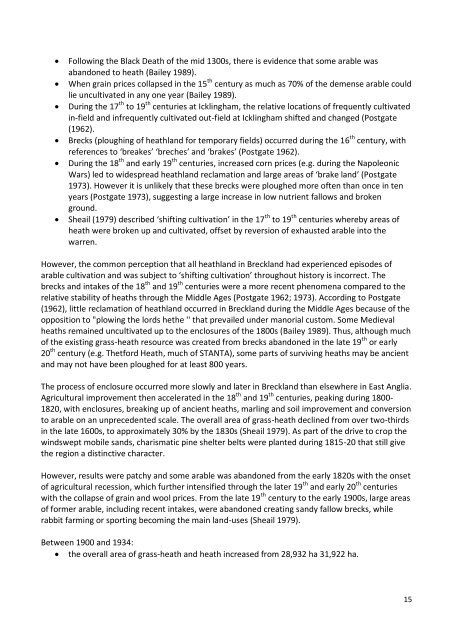Securing Biodiversity in Breckland - European Commission
Securing Biodiversity in Breckland - European Commission
Securing Biodiversity in Breckland - European Commission
You also want an ePaper? Increase the reach of your titles
YUMPU automatically turns print PDFs into web optimized ePapers that Google loves.
Follow<strong>in</strong>g the Black Death of the mid 1300s, there is evidence that some arable wasabandoned to heath (Bailey 1989).When gra<strong>in</strong> prices collapsed <strong>in</strong> the 15 th century as much as 70% of the demense arable couldlie uncultivated <strong>in</strong> any one year (Bailey 1989).Dur<strong>in</strong>g the 17 th to 19 th centuries at Ickl<strong>in</strong>gham, the relative locations of frequently cultivated<strong>in</strong>-field and <strong>in</strong>frequently cultivated out-field at Ickl<strong>in</strong>gham shifted and changed (Postgate(1962).Brecks (plough<strong>in</strong>g of heathland for temporary fields) occurred dur<strong>in</strong>g the 16 th century, withreferences to ‘breakes’ ‘breches’ and ‘brakes’ (Postgate 1962).Dur<strong>in</strong>g the 18 th and early 19 th centuries, <strong>in</strong>creased corn prices (e.g. dur<strong>in</strong>g the NapoleonicWars) led to widespread heathland reclamation and large areas of ‘brake land’ (Postgate1973). However it is unlikely that these brecks were ploughed more often than once <strong>in</strong> tenyears (Postgate 1973), suggest<strong>in</strong>g a large <strong>in</strong>crease <strong>in</strong> low nutrient fallows and brokenground.Sheail (1979) described ‘shift<strong>in</strong>g cultivation’ <strong>in</strong> the 17 th to 19 th centuries whereby areas ofheath were broken up and cultivated, offset by reversion of exhausted arable <strong>in</strong>to thewarren.However, the common perception that all heathland <strong>in</strong> <strong>Breckland</strong> had experienced episodes ofarable cultivation and was subject to ‘shift<strong>in</strong>g cultivation’ throughout history is <strong>in</strong>correct. Thebrecks and <strong>in</strong>takes of the 18 th and 19 th centuries were a more recent phenomena compared to therelative stability of heaths through the Middle Ages (Postgate 1962; 1973). Accord<strong>in</strong>g to Postgate(1962), little reclamation of heathland occurred <strong>in</strong> <strong>Breckland</strong> dur<strong>in</strong>g the Middle Ages because of theopposition to "plow<strong>in</strong>g the lords hethe '' that prevailed under manorial custom. Some Medievalheaths rema<strong>in</strong>ed uncultivated up to the enclosures of the 1800s (Bailey 1989). Thus, although muchof the exist<strong>in</strong>g grass-heath resource was created from brecks abandoned <strong>in</strong> the late 19 th or early20 th century (e.g. Thetford Heath, much of STANTA), some parts of surviv<strong>in</strong>g heaths may be ancientand may not have been ploughed for at least 800 years.The process of enclosure occurred more slowly and later <strong>in</strong> <strong>Breckland</strong> than elsewhere <strong>in</strong> East Anglia.Agricultural improvement then accelerated <strong>in</strong> the 18 th and 19 th centuries, peak<strong>in</strong>g dur<strong>in</strong>g 1800-1820, with enclosures, break<strong>in</strong>g up of ancient heaths, marl<strong>in</strong>g and soil improvement and conversionto arable on an unprecedented scale. The overall area of grass-heath decl<strong>in</strong>ed from over two-thirds<strong>in</strong> the late 1600s, to approximately 30% by the 1830s (Sheail 1979). As part of the drive to crop thew<strong>in</strong>dswept mobile sands, charismatic p<strong>in</strong>e shelter belts were planted dur<strong>in</strong>g 1815-20 that still givethe region a dist<strong>in</strong>ctive character.However, results were patchy and some arable was abandoned from the early 1820s with the onsetof agricultural recession, which further <strong>in</strong>tensified through the later 19 th and early 20 th centurieswith the collapse of gra<strong>in</strong> and wool prices. From the late 19 th century to the early 1900s, large areasof former arable, <strong>in</strong>clud<strong>in</strong>g recent <strong>in</strong>takes, were abandoned creat<strong>in</strong>g sandy fallow brecks, whilerabbit farm<strong>in</strong>g or sport<strong>in</strong>g becom<strong>in</strong>g the ma<strong>in</strong> land-uses (Sheail 1979).Between 1900 and 1934: the overall area of grass-heath and heath <strong>in</strong>creased from 28,932 ha 31,922 ha.15





